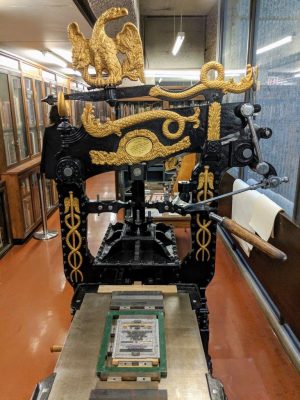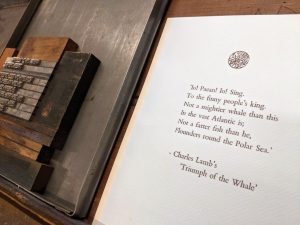La version française suit
By Ann Marie Holland, Associate Librarian, Curator Colgate History of Printing Collection, Rare Books and Special Collections
Over the summer of 2019, restoration experts at the Howard Iron Works Printing Museum carried out a complete overhaul of McGill’s Columbian press, dating back to 1821, the same year as the founding of McGill University. During the repair process, Nick Howard remarked that McGill’s Columbian was the best he had ever seen in the shop, bearing very little trace of past wear and tear. The original iron and bronze castings were polished, parts re-attached and, the carriage was refitted with new cowhide leather belts under the press bed. Its awesome aspect combined with its historical significance have generated a lot of buzz especially in the Rare Books and Special Collections space on the 4th floor of the McLennan Library Building.

Columbian hand press was manufactured in Britain in 1821 by an American engineer and brought to Canada to McGill University in 1957. Photo: Merika Ramundo
There exist only 32 presses in the world of the series designed and manufactured by George Clymer from 1817 to 1830,[1] and McGill’s Columbian is one of these. The American engineer George Clymer (1754-1834) of Philadelphia invented this press in 1813 just as iron hand-presses were being developed. Clymer manufactured and sold about 20 Columbians in the USA until about May 1817, when he sailed for England to try the more stable and established printing press market there. The third Earl of Stanhope (1758-1816) was the first to design and build an iron hand press between 1800 and 1803. Due to the integration of iron materials into printing press technology, production levels in press shops increased because of the size of sheet that the iron presses could handle, along with the accuracy and power that these presses could deliver.
Clymer incorporated iron-casting techniques for the manufacture and embellishment of the Columbian. The press is lavishly ornamented with symbolic pieces painted in gold such as the American eagle with extended wings representing might and power, clutching an olive branch and a cornucopia, representing peace and abundance. It was so distinctive that “generations of British pressmen, often unaware of the true name of the press, have referred to it as the ‘eagle’ press.”[2] On each pillar of the press frame, one notices the winged staff of Hermes, messenger of the gods in Greek mythology, intertwined by two serpents. Hermes’ presence links this great machine to communication.
McGill’s Columbian press is now accurately dated to 1821. Two features distinguish McGill’s press as an early model manufactured by Clymer himself: the pull bar located on the far side of the frame and the urn-like decorations on the legs, a decorative element that was discontinued as they were prone to breakage.
The Provenance of McGill’s Columbian Press is equally astounding. This Columbian was found abandoned in England in a basement in 1957 by Richard Pennington, McGill’s University Librarian from 1947 to 1964. Pennington brought it to McGill where it was integrated into classes on the typographical arts for students at McGill’s Library School. At this time, the Columbian was located on the basement level of the former Redpath Library through to late 1965. By 1969, the Columbian was housed on the street level of the newly built McLennan Library Building. It was last restored in 1974 by an engineer and friend to Richard Pennington, Mr. Charles Fisher, a family relation to Dr. Sydney Fisher, benefactor to the University of Toronto’s Rare Book Library.

One of the first prints produced by McGill’s Columbian press is featured in the Bodleian Libraries’ “Very Like a Whale” collaborative printing project. Photo: Merika Ramundo
Since 1997, the Columbian Press has been housed on the 4th floor of the McLennan Library Building, in the expanded Rare Books and Special Collections branch of the McGill Library where it is cleverly put on view so that it can be seen through the glassed-in stairway. Representing the history of the hand press, the book arts and the history of iron machine technology, it is a drawing card for public tours and class visits alike.
An official launch of the press will take place in early 2020. Watch for more information as we move towards programming special workshops and demos for one of the most exciting initiatives on the go in the McGill Library, led by staff members of the McGill Library Book Arts Innovation Lab (Jennifer Garland, Lauren Williams, Ann Marie Holland and Anna Dysert).
Update: The Book Arts Laboratory was opened January 30th, 2020. Read more about our print shop here.
Did you know?
McGill’s Columbian is the earliest surviving model in North America of this early manufacture and perhaps the largest. This press was always at the core of a project conceived in 2015 in response to the Dean of Libraries’ call for Innovation in Service proposals. The Books Arts Team is grateful to the Dean of Libraries, C. Colleen Cook, for the exceptional funding provided to complete a crucial stage of the establishment of a Books Arts Programme.
[1] Robert Oldham, “The Columbian Press at 2000: Report on a World Wide Census”, Journal of the Printing Historical Society, New series, No. 21, Autumn 2014, Appendix 1, p. 61.
[2] James Moran, Printing Presses, History and Development from the Fifteenth Century to Modern Times, Berkeley: Univ. of California Press, 1973, p. 60.
Une impression durable : restauration de la presse à bras Columbian
Par Ann Marie Holland, bibliothécaire associée, conservatrice de la Collection Colgate sur l’histoire de l’impression, Livres rares et collections spécialisées
Au cours de l’été 2019, des spécialistes en restauration du Howard Iron Works Printing Museum ont effectué la révision exhaustive de la presse Columbian, dont la fabrication en 1821 coïncide avec l’année de fondation de l’Université McGill. Pendant les réparations, Nick Howard a fait remarquer qu’aucune autre presse restaurée dans son atelier n’avait été en aussi bon état ou montré aussi peu de signes d’usure. Les restaurateurs ont poli les pièces d’origine coulées en fer et en bronze, remis certaines pièces en place et remplacé les courroies en cuir de vache du chariot sous la table de la presse. Par ses dimensions imposantes et sa valeur historique, la presse Columbian a suscité beaucoup d’attention surtout dans la section des Livres rares et collections spécialisées située au 4e étage du pavillon McLennan.

PresseColumbian fabriquée en Grande-Bretagne en 1821 par un ingénieur américain et transportée au Canada à l’Université McGill en 1957. Photo Merika Ramundo
À l’heure actuelle, il ne reste que 32 des presses conçues et fabriquées par George Clymer entre 1817 et 1830, dont la presse Columbian acquise par l’Université McGill[1]. L’invention de cette presse par cet ingénieur américain originaire de Philadelphie (1754-1834) remonte à 1813, alors que les premières presses à bras en fer faisaient leur apparition. Après avoir fabriqué et vendu environ 20 presses Columbian aux États-Unis, Clymer s’est embarqué pour l’Angleterre en mai 1817 pour tenter sa chance sur ce marché plus stable et mieux établi. La première presse à bras en fer a été conçue et construite par le troisième comte de Stanhope (1758-1816), entre 1800 et 1803. L’intégration du fer dans la fabrication de ces machines a permis aux imprimeurs d’augmenter leur capacité de production, car ces presses pouvaient accueillir de plus grands feuillets, offraient plus de précision et étaient plus puissantes.
Clymer a exploité les techniques de fonderie pour fabriquer et embellir sa presse Columbian, qui est richement ornée de pièces emblématiques peintes en or, comme un aigle américain aux ailes étendues symbolisant la force et la puissance, qui tient dans ses serres une branche d’olivier et une corne d’abondance représentant la paix et la prospérité. Cet ornement était tellement distinctif que « la presse Columbian a été appelée presse à aigle par des générations d’imprimeurs britanniques souvent ignorants de son nom véritable »[2]. Sur chaque pilier du bâti de la presse, on remarque un bâton autour duquel s’enroulent deux serpents, le caducée d’Hermès. Ce symbole du messager des dieux grecs antiques illustre le rôle de la presse dans les communications.
Il est maintenant confirmé que la presse Columbian de l’Université McGill date de 1821. Deux caractéristiques indiquent qu’il s’agit d’un des premiers modèles fabriqués par Clymer même : son levier situé sur le côté du bâti et la décoration en forme d’urne de ses pattes, abandonnée sur les modèles suivants en raison de sa fragilité.
La provenance de cette presse Columbian est tout aussi étonnante. C’est Richard Pennington, bibliothécaire de l’Université McGill de 1947 à 1964, qui l’a trouvée à l’abandon dans un sous-sol en 1957, en Angleterre. Pennington a fait transporter la presse sur le campus pour l’utiliser dans le cadre des cours de typographie offerts à l’école de bibliothéconomie de l’Université. La presse a d’abord séjourné au sous-sol de l’ancienne bibliothèque Redpath, jusqu’à la fin de 1965. En 1969, on l’a déménagée au rez-de-chaussée du pavillon McLennan nouvellement construit. Sa dernière restauration en 1974 avait été confiée à Charles Fisher, ingénieur et ami de Richard Pennington et parent du Dr Sydney Fisher, qui était un bienfaiteur de la bibliothèque de livres rares de l’université de Toronto.

Un des premiers impressions de la presse colombienne de McGill est présenté dans le cadre du projet collaboratif “Very Like a Whale” des bibliothèques Bodleian. Photo Merika Ramundo
Depuis 1997, la presse Columbian est conservée au 4e étage de la bibliothèque McLennan de l’Université McGill, habilement mise en valeur dans la rallonge de la section des Livres rares et collections spécialisées, où on peut l’admirer de l’escalier vitré. Cet exemple représentatif de l’histoire des presses à bras et de la technologie des machines de fer ainsi que des arts du livre constitue un attrait pour les visites publiques et les sorties de classes.
L’inauguration officielle de la presse aura lieu au début de 2020. Surveillez notre page pour en savoir plus sur cet événement et la programmation d’ateliers spéciaux et de démonstrations portant sur une des plus emballantes initiatives en cours à la bibliothèque de l’Université McGill, dirigée par les membres du laboratoire d’innovation dans les arts du livre (Jennifer Garland, Lauren Williams, Ann Marie Holland et Anna Dysert).
Mise-à-jour: Le Laboratoire des arts du livre a commencé ses activités le 30 janvier 2020. Pour plus d’information cliquer ici.
Le saviez-vous?
La presse Columbian conservée à l’Université McGill est un des plus anciens exemples des débuts de la fabrication des presses qui subsiste en Amérique du Nord et probablement le plus imposant. Elle a toujours été au cœur d’un projet élaboré en 2015 en réponse à l’appel de propositions d’Innovation in Service lancé par la doyenne des bibliothèques. L’équipe des Arts du livre remercie la doyenne des bibliothèques C. Colleen Cook pour le financement exceptionnel qui a rendu possible l’achèvement d’une étape cruciale de l’établissement d’un programme d’études des arts du livre.
[1] Robert Oldham, “The Columbian Press at 2000: Report on a World Wide Census”, Journal of the Printing Historical Society, New series, N° 21, Autome 2014, Annexe 1, p. 61.
[2] James Moran, Printing Presses, History and Development from the Fifteenth Century to Modern Times, Berkeley: Univ. of California Press, 1973, p. 60.













Leave a Reply
You must be logged in to post a comment.